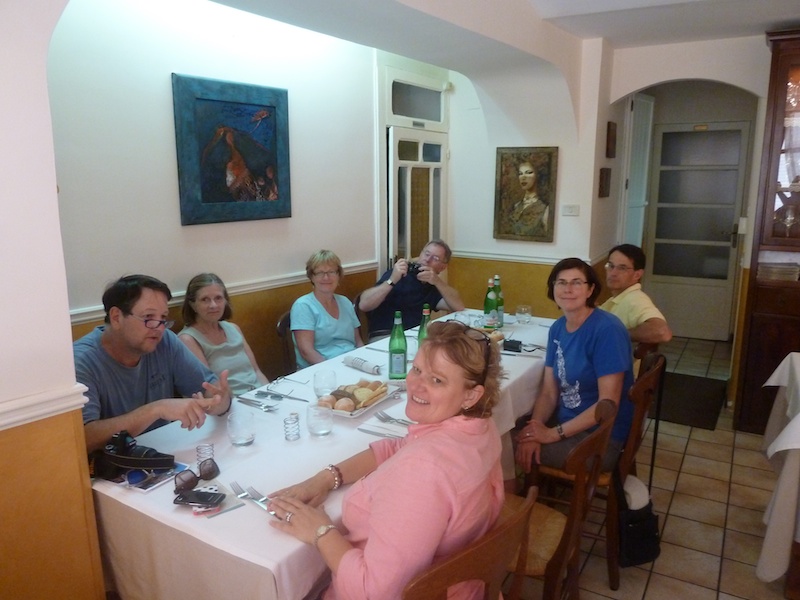 With so much history, with an incredibly complex and interesting culture, with natural resources galore, not least of which is the sea that surrounds this enchanting and intoxicating island, one could almost overlook food as a source of adventure and pleasure on a visit to Sicily. But then one wouldn’t be Bill and Suzy.
With so much history, with an incredibly complex and interesting culture, with natural resources galore, not least of which is the sea that surrounds this enchanting and intoxicating island, one could almost overlook food as a source of adventure and pleasure on a visit to Sicily. But then one wouldn’t be Bill and Suzy.
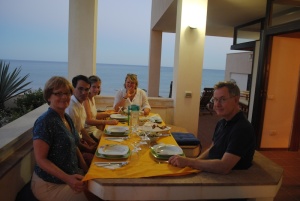 Since our arrival on Saturday food has played a big role in our Sicilian odyssey, just not a central one. We have spent many of our meals and most of our dinners at the villa, enjoying the cool breezes that wash over our outdoor terrace, eating lots of simple fresh dishes cooked up by this group of American cooks trying to tap into their inner Sicilian. To be sure, we have gone native as well. Our first night at Villa Zeffiro included a dinner prepared by our hostess Gabriella Becchina, featuring a special “detox soup,” a recipe concocted by her very Sicilian father, Sicilian long squash (we think it’s called cucuzza) cooked soft, fish rolls made with fresh swordfish and a light citrus granita. Subsequent home cooked dinners have featured grilled fresh vegetables, couscous and other light salads including a perfect summer panzanella salad and Sicilian tomatoes with fresh mozzarella. Lots of pane nero di castelvetrano, a dark, dense and slightly sweet bread made from a special local grain has been consumed at dinner and at breakfast, when it is spread thick with fresh butter. For the most part, however, the emphasis has been on fresh and light, simple yet satisfying.
Since our arrival on Saturday food has played a big role in our Sicilian odyssey, just not a central one. We have spent many of our meals and most of our dinners at the villa, enjoying the cool breezes that wash over our outdoor terrace, eating lots of simple fresh dishes cooked up by this group of American cooks trying to tap into their inner Sicilian. To be sure, we have gone native as well. Our first night at Villa Zeffiro included a dinner prepared by our hostess Gabriella Becchina, featuring a special “detox soup,” a recipe concocted by her very Sicilian father, Sicilian long squash (we think it’s called cucuzza) cooked soft, fish rolls made with fresh swordfish and a light citrus granita. Subsequent home cooked dinners have featured grilled fresh vegetables, couscous and other light salads including a perfect summer panzanella salad and Sicilian tomatoes with fresh mozzarella. Lots of pane nero di castelvetrano, a dark, dense and slightly sweet bread made from a special local grain has been consumed at dinner and at breakfast, when it is spread thick with fresh butter. For the most part, however, the emphasis has been on fresh and light, simple yet satisfying.
But then again, when the sun is shining, the sea is lapping softly on the shore and a cool, soft, salt breeze licks your face, everything tastes good and tends to satisfy. On a day when we were making new friends during our visit to the Planeta winery, the “junk food” lunch picked out by Giovanni, Carlos and me – consisting of simple panini with sliced meats and cheese, a sandwich that could best be described as a Sicilian hot dog, chick pea fritters called panelle and a beloved dish in Sicily, aranciata (fried rice balls stuffed with meat) –could easily have been confused with a gourmet meal dreamed up by Mario Batali. Food, and the enjoyment of it, is most often much, much more than the sum of its parts.
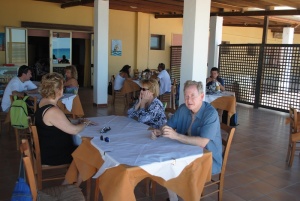 And so on our second day here, under a blazing early afternoon sun, John, Willia, Suzy and I trudged through the cool, surf drenched sand along the water’s edge to enjoy lunch on the shaded outdoor terrace of the nearby Hotel Aureus. There, the magnetic and personable proprietor by the name of Filippo shared with us his and his family’s love of Sicilian food and culture. The mop haired son of a local wine and olive oil making family, Filippo’s smile and enthusiasm for his family’s patrimony and simple traditional Sicilian fare featuring fresh catch from the sea and zero kilometer produce from the land was contagious. On our first visit we sampled sarde beccafico, a traditional antipasto made from fresh sardines and filled with bread crumbs, olive oil, pine nuts and raisins. For our main courses I ordered a homemade casareccia pasta with small shrimps and a cream sauce of chopped pistachio. Suzy ordered a plate of lightly fried gamberi, small shrimp served with their head and tails on. The pasta was a revelation, one of those jaw dropping moments where you taste something so good as to actually take leave of your senses. Suzy must have seen me struggling to regain my consciousness and instead of performing the Heimlich maneuver, she speared a few pastas and ate them. Within minutes I was enjoying her plate of gamberi fritti, eating heads and tails along with the body, while my casareccia was being devoured by Suzy.
And so on our second day here, under a blazing early afternoon sun, John, Willia, Suzy and I trudged through the cool, surf drenched sand along the water’s edge to enjoy lunch on the shaded outdoor terrace of the nearby Hotel Aureus. There, the magnetic and personable proprietor by the name of Filippo shared with us his and his family’s love of Sicilian food and culture. The mop haired son of a local wine and olive oil making family, Filippo’s smile and enthusiasm for his family’s patrimony and simple traditional Sicilian fare featuring fresh catch from the sea and zero kilometer produce from the land was contagious. On our first visit we sampled sarde beccafico, a traditional antipasto made from fresh sardines and filled with bread crumbs, olive oil, pine nuts and raisins. For our main courses I ordered a homemade casareccia pasta with small shrimps and a cream sauce of chopped pistachio. Suzy ordered a plate of lightly fried gamberi, small shrimp served with their head and tails on. The pasta was a revelation, one of those jaw dropping moments where you taste something so good as to actually take leave of your senses. Suzy must have seen me struggling to regain my consciousness and instead of performing the Heimlich maneuver, she speared a few pastas and ate them. Within minutes I was enjoying her plate of gamberi fritti, eating heads and tails along with the body, while my casareccia was being devoured by Suzy.
Several nights later, our group, which had now grown to 8 returned to La Terazza for dinner. We must have made an impression on Filippo at the previous lunch, for he spent the entire meal recommending various Sicilian specialties and having us try other wines from his family’s award winning selection. He even appreciated me mock spitting out the first taste of wine, which he presented with a flourish, so sure that we would love it. We did.
That dinner we gained at least three additional converts to the “this casareccia pasta with gamberi and pistachio cream sauce is the best thing I have ever eaten” club. It is hard to describe this unlikely combination of ingredients working in such incredibly sublime harmony, but they do. And the secret is the shrimp, small and, frankly, unimpressive looking in the slightly creamy sauce, but imbuing the dish with a light sweetness that suffuses the whole. American farm raised shrimp, so good to look at but so dull in flavor and entirely lacking in this sort of soft yet persistent sweetness would never successfully substitute. This is a dish that must be eaten here in Sicily, preferably on a simple cement slab terrace covered from the sun with the gentle lapping of the Mediterranean providing the background music. It doesn’t hurt to wash it down with Filippo’s 100% inzolio white wine or a couple bottles of his 100% catarrato.
But as good as the simple casareccia dish is, there are others on Filippo’s menu that give it a run for the euro. One was the traditional caponata, a stewy antipasto made from eggplant, peppers, capers and other fresh vegetables. The two dishes we ordered for our table of 8 disappeared within seconds. A special pasta made with sgombero (mackerel) was also hailed as special as was my tonnino, steaks made from a small tuna that was served in a picante broth. All this from the little hotel restaurant frequented by perhaps six other patrons, a few hundred yards’ walk down the beach from our beach house.
* * *
On our fourth day we decided to take a trip along the coast to Mazara del Vallo, a town 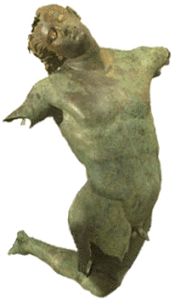 housing one of the island’s most important fishing fleets and home to a famous Greek statue, a dancing satyr in bronze attributed to the Greek master Praxiteles. This was our second visit to the Satiro di Mazaro but the rest of the group, for whom it was the first time fell quickly under the spell of its story (it was hauled up quite by accident in the nets of a local fishing boat) and its artistic power.
housing one of the island’s most important fishing fleets and home to a famous Greek statue, a dancing satyr in bronze attributed to the Greek master Praxiteles. This was our second visit to the Satiro di Mazaro but the rest of the group, for whom it was the first time fell quickly under the spell of its story (it was hauled up quite by accident in the nets of a local fishing boat) and its artistic power.
But just up the road, in the sprawling city of Trapani we were about to fall under the spell of another artistic power, the power of the kitchen at the restaurant Le Mura. Pulling up to Le Mura, from the outside an unassuming glassed in patio in a wide street along Trapani’s quay and next door to a large fortress, we were not at all prepared for what was to lay in store. We snapped a few photos of the bay on which Trapani is situated, with the towering mountain on which stands nearby Erice in the background. Then we entered and were greeted by a couple of genial young waiters who showed us to a table with a view of the bay. Then the feast began.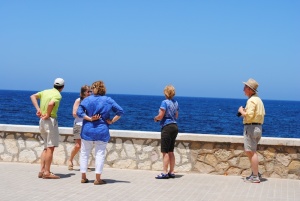
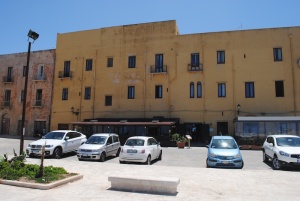
But not before our waiter asked us, in perfect English, where we were from. When we replied that most of us were from Washington, DC he replied, “me, too!” Well not exactly Washington, DC he confessed, “Arlington, Virginia. I live there six months of the year with my girlfriend and she lives six months here.” Dario (the waiter’s name) then confessed that it was Shirlington, not Arlington, but the improbable coincidence was not diminished. And a few moments later he emerged from the kitchen with his cellphone, handing it to me to speak with his girlfriend, back in Shirlington, to prove to her that some Washingtonians were in his restaurant. They both spoke of their love for Fiola, our favorite Italian restaurant back in Washington, and so addresses were shared and a plan was made to dine together at Fiola this fall. Another one for the “small world” record books.
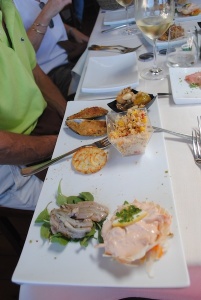 After all of this, we settled into our food and for nearly three hours the six of us shared every delicious sea creature known to man. An antipasto featuring six delicacies – a “cocktail” of small shrimps, dressed in a homemade aioli and served in a scallop shell, a lightly fried cake of cod fish, tart, tangy sardines, split open and deboned and soft and savory on the palate, a couscous salad, traditional caponata and baked mussels. Then, on the side, two heaping plates of moscardini, tiny calamari lightly flash fried and dusted with a coarse flour. These Sicilian treats could pass as popcorn shrimp in the States.
After all of this, we settled into our food and for nearly three hours the six of us shared every delicious sea creature known to man. An antipasto featuring six delicacies – a “cocktail” of small shrimps, dressed in a homemade aioli and served in a scallop shell, a lightly fried cake of cod fish, tart, tangy sardines, split open and deboned and soft and savory on the palate, a couscous salad, traditional caponata and baked mussels. Then, on the side, two heaping plates of moscardini, tiny calamari lightly flash fried and dusted with a coarse flour. These Sicilian treats could pass as popcorn shrimp in the States.
But as good as the antipasti were, it was the platters of fried and grilled seafood that stole the show. There were grilled and fried shrimp, big ones the size of a man’s fist, grilled rings of calamari and thick, thick triangles of tuna steak. And it was the tuna that stole the show despite the fact the chef did literally nothing to it. Literally everyone at the table was salivating over this incredible tuna, with its intense yet balanced tuna flavor and its subtle shadings. What, we asked did the chef flavor this with? The answer – it was grilled on a hot grill to sear it (that was obvious from the lightly crunch texture of the outside) and brushed with a little olive oil. That’s all. This symphony of flavors came from within, from the freshness and naturalness of the tuna itself which, we learned, is best when fished from local waters in May and June. Who knew that tuna had a season. We were raised thinking it only had an expiration date.
* * *
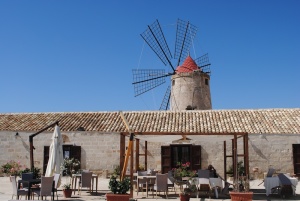 A brief detour on the way home from Trapani held yet another culinary treat, a visit to the salt pans of Trapani in the nearby town of Nubia. Here we saw vast mounds of salt piled up next to large rectangular pools of evaporating salt water and learned how the highly salenic seawater is moved from pool to pool by manmade channels using windmills to turn Archimedes screws, how saltmakers prime the saltwater with an activating water similar to mother of yeast, how the auxiliary pools are freshened and amplified and finally how the crystals, which can grow as large as soccer balls, are extracted and processed. It was our third visit to a salt flat and as strange as it seems, it is something we will never grow tired of.
A brief detour on the way home from Trapani held yet another culinary treat, a visit to the salt pans of Trapani in the nearby town of Nubia. Here we saw vast mounds of salt piled up next to large rectangular pools of evaporating salt water and learned how the highly salenic seawater is moved from pool to pool by manmade channels using windmills to turn Archimedes screws, how saltmakers prime the saltwater with an activating water similar to mother of yeast, how the auxiliary pools are freshened and amplified and finally how the crystals, which can grow as large as soccer balls, are extracted and processed. It was our third visit to a salt flat and as strange as it seems, it is something we will never grow tired of.
* * *
Our final food story, at least for now, takes place in Sciacca, another important fishing town in the opposite direction from the beach house from Mazaro del Vallo. We planned a trip there to visit some ceramics producers, as Sciacca is the home of a large colony of ceramics artists who have been painting designs developed back in the 1600s. We were a little surprised and somewhat disappointed when we arrived in town, expecting to find a quaint seaside artists’ village but instead finding a hot, crowded and decidedly run down 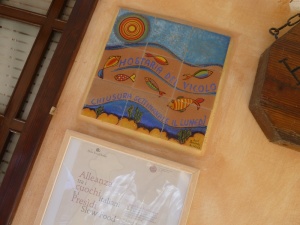 town with a bustling seaport but a rather dilapidated historic center. We walked around for an hour or so and decided to try to salvage the day by finding a good meal. Given the depressed state of things in this town, we were not hopeful.
town with a bustling seaport but a rather dilapidated historic center. We walked around for an hour or so and decided to try to salvage the day by finding a good meal. Given the depressed state of things in this town, we were not hopeful.
But we did indeed find the promised land. Tucked back in a very narrow alley, under a pointed arch that leads off a small square is the restaurant Hostaria del Vicolo, an elegant, refined and utterly enjoyable oasis in what we found to be an otherwise bland desert. Our waiter, like Dario, spoke excellent English and like Dario and Filippo, was passionate about the food of his native Sicily and particularly the seafood of his native Sciacca. But the restaurant proudly featured a number of items from the Slow Food Presidia, a list of important and tasty local dishes and ingredients that have been recognized by this international group of foodies. And our lunch that day featured a number of Presidia items.
 We started with five antipasti, shared among the eight of us so as to allow us to sample numerous tastes and because we didn’t want to not order anything on the menu. Several of the antipasti plates themselves included multiple items, so strap on your seatbelt as we recount the menu – a zucchini wrap filled with polpo (octopus), monkfish with saffron zucchini and pistachio crusted red mullet, which was accompanied by a warm octopus and shrimp salad, a trio of raw fish that included blue fish, red shrimp and white fish (better known as one fish, two fish, red shrimp, blue fish), a bed of mashed potato with truffle, octopus, sundried tomatoes and lentils and a trio (of course) of rices – brown rice with marinated fish and herbs, black rice with pineapple, shrimp and mint and brown rice with cod, almond and cinnamon. So endeth the antipasti.
We started with five antipasti, shared among the eight of us so as to allow us to sample numerous tastes and because we didn’t want to not order anything on the menu. Several of the antipasti plates themselves included multiple items, so strap on your seatbelt as we recount the menu – a zucchini wrap filled with polpo (octopus), monkfish with saffron zucchini and pistachio crusted red mullet, which was accompanied by a warm octopus and shrimp salad, a trio of raw fish that included blue fish, red shrimp and white fish (better known as one fish, two fish, red shrimp, blue fish), a bed of mashed potato with truffle, octopus, sundried tomatoes and lentils and a trio (of course) of rices – brown rice with marinated fish and herbs, black rice with pineapple, shrimp and mint and brown rice with cod, almond and cinnamon. So endeth the antipasti.

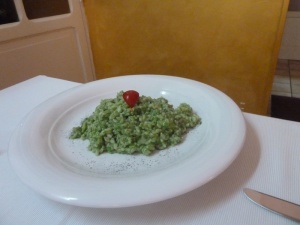 Desiring to cut back on the next course, we limited ourselves to four main courses, which were also shared among all. These included green rice with herbs and monkfish, paccheri pasta with red shrimps, grilled hen fish with citrus and ginger and, finally, fish with fava bean puree and black pig bacon.
Desiring to cut back on the next course, we limited ourselves to four main courses, which were also shared among all. These included green rice with herbs and monkfish, paccheri pasta with red shrimps, grilled hen fish with citrus and ginger and, finally, fish with fava bean puree and black pig bacon.
And although we have not generally limited our desserts in Sicily to fresh fruits, we figured we had saved enough room to 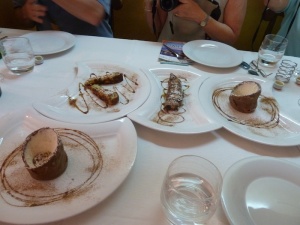 sample three – a canolli on the half shell a “typical sweet sage and ricotta tart” and a crepe with ricotta, honey and cinnamon. They were so good that Suzy, not much a fan of Italian desserts, said it restored her faith in Sicily as the protector of the Italian dolce.
sample three – a canolli on the half shell a “typical sweet sage and ricotta tart” and a crepe with ricotta, honey and cinnamon. They were so good that Suzy, not much a fan of Italian desserts, said it restored her faith in Sicily as the protector of the Italian dolce.
So there you have it. Our days here in Sicily have been jammed full of daytrips – to wineries, Greek temples, visiting fished out Greek sculptures, salt mines and ancestral towns. We have covered hundreds of kilometers along autostrade and winding country lanes so narrow and isolated that it led us to hypothesize that my GPS was somehow set on “Robert Frost” mode, 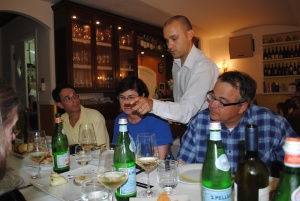 selecting only the roads less travelled. But along the way we have made time to get to know the food of this island and to meet some interesting folks that know it and can communicate its special qualities. It is time that has been most worthwhile carving out.
selecting only the roads less travelled. But along the way we have made time to get to know the food of this island and to meet some interesting folks that know it and can communicate its special qualities. It is time that has been most worthwhile carving out.
Ci vediamo!
Bill and Suzy

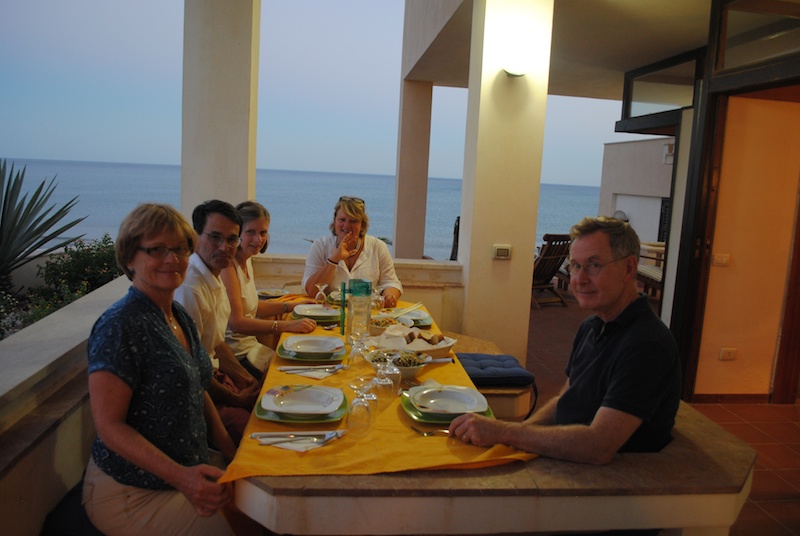
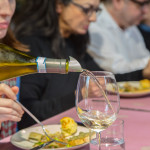
About The Author
Related Posts
Home. That's what Cannara has become. Home.Read more »
To Start Pardi Colle di Giove (Grechetto, Chardonnay, Trebbiano Spoletino) Pinzimonio Bruschetta with olive oil …